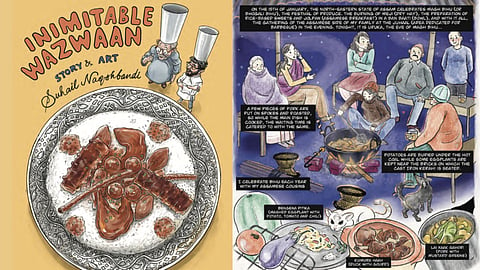
- HOMEGROWN WORLD
- #HGCREATORS
- #HGEXPLORE
- #HGVOICES
- #HGSHOP
- CAREERS
- ABOUT US
- CONTACT US

Food in India is a language that cuts across generations, a cornerstone of history, and the very foundation upon which communities and cultures are built. In other words, it is synonymous with love, faith, and a deep sense of belonging.
But the narrative surrounding Indian cuisine often gets reduced to a simplified North-South divide, with idli-dosa representing the South and chole bhatura or aloo paratha embodying the North. This oversimplification erases the rich assortments of regional cuisines, each posessing distinctive traditions and flavours.
Here's where 'Fellowship of Food' steps in, a comic by Comixense that serves as a much-needed corrective. Launched in April 2021, this quarterly comic magazine targets teenagers while tackling various aspects of contemporary Indian life with intelligence, empathy, and respect for their young audience's imagination. Each issue revolves around a central theme, with the latest edition focusing on the multifaceted role food plays in our lives.
The cover art itself, inspired by Charles Dickens' classic 'Oliver Twist', hints at the exploration of diverse culinary experiences. Inside, five distinct stories unfold, each delving into the intricate relationship between food and culture. We encounter stories that celebrate food's power to foster togetherness and self-sufficiency. Others tackle more serious issues like hunger and its complexities or the guilt associated with certain food choices.
'Eating Saraswati's Bahon' takes us to Assam, where a young girl grapples with a dilemma; a food choice caught between religious restrictions and cultural practices. This story beautifully highlights the delicate balance that often exists within Indian food traditions.
Assam's cuisine reflects the region's rich cultural heritage and diverse geography. Traditional cooking techniques such as steaming, roasting, and fermenting are prevalent. Assamese cuisine has evolved through interactions with neighbouring regions and communities; creating some of the cherished aspects of Assamese culture and identity we now see today.
According to the 2023 Global Hunger Index, India ranks 111th out of 125 countries, indicating a "Serious" level of hunger. A 2023 NITI Aayog report highlights that despite poverty reduction, 74.1% of the population cannot afford healthy food. 'Hunger' by Kavita Singh Kale tackles this harsh reality in India.This story sheds light on the issue of internal migration, often driven by economic distress and lack of access to food. Millions migrate from villages to cities, where they might struggle to find employment or face competition in unfamiliar job markets. The comic explores the plight of such migrants, like the driver in the story, who finds solace and sustenance in langars — community kitchens run by gurudwaras (Sikh places of worship). Langar, a core principle of Sikhism, involves the preparation and serving of free food to anyone in need.
The comics also shine light on Kashmiri food with 'Inimitable Wazwaan' (story and art by Suhail Naqshbandi), which delves into the world of wazwaan, a multi-course feast prepared by traditional Kashmiri chefs (wazas) for special occasions. The spread can consist of up to 32 dishes, painstakingly prepared over several days. The experience extends beyond the food itself. Guests share a large serving platter (traami) fostering camaraderie. Kashmiri cuisine is heavily meat-based, with mutton and chicken being favored ingredients. However, there are vegetarian options using haak (local greens), mushrooms, or paneer. The fragrant Kashmiri chili adds color rather than heat, while cockscomb flower (mawal) creates a vibrant red hue in some dishes. Rice serves as a staple, while bakers (qandarwan) prepare leavened breads like lavash, baqarkhani, and sheermal, reflecting Central Asian influences.
The Tell-tale Tails by Pankaj Saikia) explores the world of Sikkimese cuisine, a blend of Tibetan, Nepali, and Lepcha influences. Located in the Eastern Himalayas, Sikkim offers a unique culinary experience. Traditional dishes are largely rice-based, featuring organic vegetables like pumpkin,
Lastly, One story, 'Ukai' ventures beyond Indian borders, transporting us to Japan where a young boy grapples with the relevance of the traditional cormorant fishing practices. This narrative device reminds us that food is a universal language that connects cultures across geographical boundaries.
By showcasing the emotional, cultural, and social dimensions of food, 'Fellowship of Food' offers an opportunity for young Indians to appreciate the complexity and abundance of their culinary heritage. It prevents the erasure of regional food cultures and fosters a sense of inclusivity by celebrating the sheer diversity that defines Indian cuisine.
Get your comics here.
If you enjoyed reading this, here's more from Homegrown:
'The Spice Box' Is A Picturebook Sensory Celebration Of Food, Heritage, & Tradition
4 Homegrown Creators Who Are Exploring Personal Identity & Culture Through Food
Rohit Nandha's Single-Page Recipes Are Bringing Food Poetics & Design To Your Plates
